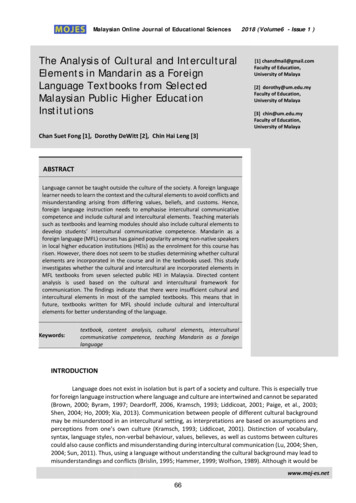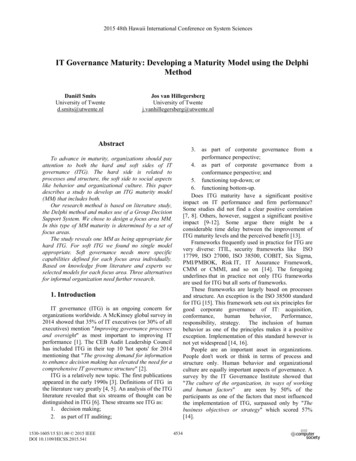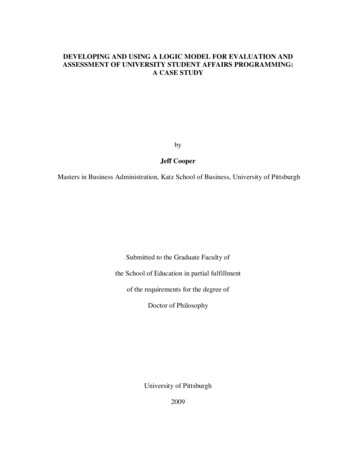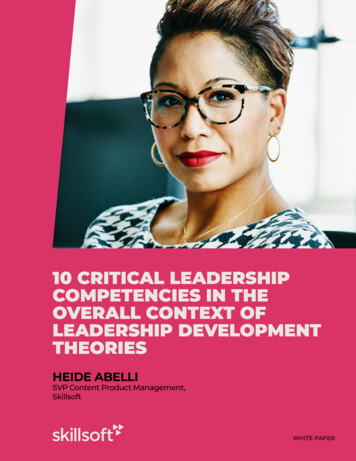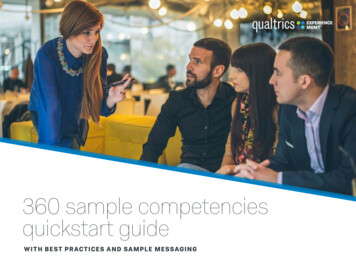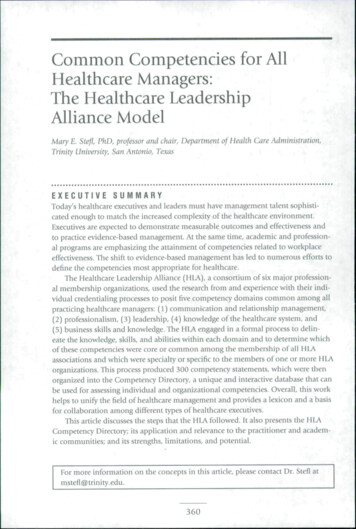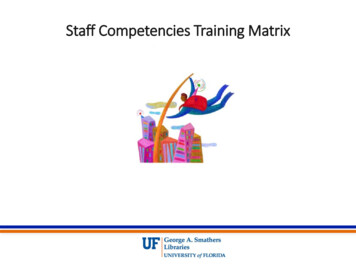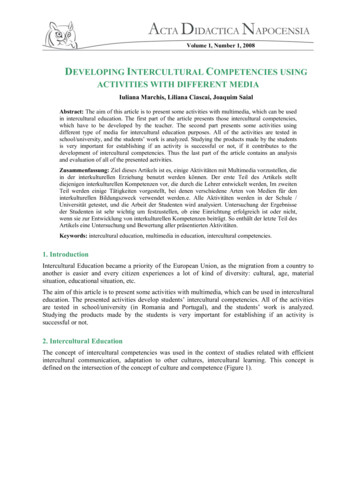
Transcription
Volume 1, Number 1, 2008DEVELOPING INTERCULTURAL COMPETENCIES USINGACTIVITIES WITH DIFFERENT MEDIAIuliana Marchis, Liliana Ciascai, Joaquim SaialAbstract: The aim of this article is to present some activities with multimedia, which can be usedin intercultural education. The first part of the article presents those intercultural competencies,which have to be developed by the teacher. The second part presents some activities usingdifferent type of media for intercultural education purposes. All of the activities are tested inschool/university, and the students’ work is analyzed. Studying the products made by the studentsis very important for establishing if an activity is successful or not, if it contributes to thedevelopment of intercultural competencies. Thus the last part of the article contains an analysisand evaluation of all of the presented activities.Zusammenfassung: Ziel dieses Artikels ist es, einige Aktivitäten mit Multimedia vorzustellen, diein der interkulturellen Erziehung benutzt werden können. Der erste Teil des Artikels stelltdiejenigen interkulturellen Kompetenzen vor, die durch die Lehrer entwickelt werden, Im zweitenTeil werden einige Tätigkeiten vorgestellt, bei denen verschiedene Arten von Medien für deninterkulturellen Bildungszweck verwendet werden.e. Alle Aktivitäten werden in der Schule /Universität getestet, und die Arbeit der Studenten wird analysiert. Untersuchung der Ergebnisseder Studenten ist sehr wichtig um festzustellen, ob eine Einrichtung erfolgreich ist oder nicht,wenn sie zur Entwicklung von interkulturellen Kompetenzen beiträgt. So enthält der letzte Teil desArtikels eine Untersuchung und Bewertung aller präsentierten Aktivitäten.Keywords: intercultural education, multimedia in education, intercultural competencies.1. IntroductionIntercultural Education became a priority of the European Union, as the migration from a country toanother is easier and every citizen experiences a lot of kind of diversity: cultural, age, materialsituation, educational situation, etc.The aim of this article is to present some activities with multimedia, which can be used in interculturaleducation. The presented activities develop students’ intercultural competencies. All of the activitiesare tested in school/university (in Romania and Portugal), and the students’ work is analyzed.Studying the products made by the students is very important for establishing if an activity issuccessful or not.2. Intercultural EducationThe concept of intercultural competencies was used in the context of studies related with efficientintercultural communication, adaptation to other cultures, intercultural learning. This concept isdefined on the intersection of the concept of culture and competence (Figure 1).
Developing Intercultural Competencies using activities with different ultural competenciesFigure 1. Elements, which form the intercultural competencyRakotomena (2005) formulate the intercultural competencies as a set of competencies necessary for asuccessful interaction in a group of persons from different cultures. Intercultural competencies arebased on knowledge about culture in general, own cultural and other cultures in particular capacities: behavior, adaptation, conflict management, negotiation capacities, competencies: flexibility, open mindness, intelligence, empathy, interdependence, optimism,tolerance psychological and emotional resources: motivation, pleasure of risks, stress managementcapacitiesTaylor (1994) considers intercultural competency as a process, not a result of an activity. Thedevelopmental model of intercultural sensitivity was created by Bennett (Bennett 1986, 1993) as aframework to explain the reactions of people to cultural difference. Using concepts fromcognitive psychology and constructivism, he identified six stages of increasing sensitivity to culturaldifference. The first three stages are ethnocentric, meaning that one’s own culture is experienced ascentral to reality in some way; the second three stages are ethno- relative, meaning that one’s ownculture is experienced in the context of other cultures. In the following we present these stages: Denial of cultural difference is the state in which one’s own culture is experienced as the only realone. Other cultures are avoided by maintaining psychological and/or physical isolation fromdifferences. Defense against cultural difference is the state in which one’s own culture (or an adopted culture)is experienced as the only good one. The world is organized into “us and them”, where “we” aresuperior and “they” are inferior. These people tend to be highly critical of other cultures. Minimization of cultural difference is the state in which elements of one’s own culturalworldview are experienced as universal. People of this development level expect similarities, andthey may become insistent about correcting others’ behavior to match their expectations. Acceptance of cultural difference is the state in which one’s own culture is experienced as justone of a number of equally complex worldviews. People reaching this level are curious about andrespectful toward cultural difference, but this doesn’t mean that the observed cultural differencesmay not be judge negatively. Adaptation to cultural difference is the state in which the experience of another culture yieldsperception and behavior appropriate to that culture. People reaching this level are able to look atthe world “through different eyes” and may intentionally change their behavior to communicatemore effectively in another culture.40
Iuliana Marchis, Liliana Ciascai, Joaquim Saial Integration of cultural difference is the state in which one’s experience of self is expanded toinclude the movement in and out of different cultural worldviews.Intercultural Education has the aim of developing intercultural competencies. The goals ofIntercultural Education were defined by Rus (2003), at four levels:3.to acquire knowledge regarding the culture in general and the impact of the culture onthe individual and groups behaviors, regarding the own culture/cultures and regardinganother cultures;4.to develop skills in connection with life in multicultural/intercultural society (theawareness of own cultural determinations, stereotypes and prejudices, the identificationof these skills to the others, the capacity to make more acceptable/ relative the points ofview, the communication and skills and the relationships);5.to construct attitudes as there are: respect of cultural diversity, of own cultural identity,of culture of the other one, to refuse the discrimination and intolerance;6.the stimulation of participation and action in the scope of the promotion of theprinciples of intercultural society and to fight against the discrimination and intolerance.3. Activities using different mediaIn the following, we present some activities with students, which uses multimedia for developingintercultural competencies. These activities develop complex competencies, beside the interculturalcompetencies; they contribute to the development of media literacy, too. During some of the presentedactivities students learn how to use computers for making complex multimedia products.The following two activities use photos and they can be applied for every age group, from primaryschool to university level. It is important that the teacher chooses photos appropriate to the age of thestudents. The discussions related with the photos could be deeper if the students are older.A good start for a discussion about interculturality is to identify the intercultural message of a photo.1. Activity: Intercultural message of a photoObjectives/Competencies- To read the intercultural message of a photo;- To formulate intercultural messages;- To describe feelings related with people from other cultures.Time 50 minutesResources- A photo (in digital form) with intercultural messages;- Laptop, projector.Steps of the activity:- The teacher projects the photo, students have to write down the message of the presented photo;- Each student reads the message;Reflection and evaluation- The teacher starts a discussion in the class about comparing the messages written by differentstudents;- The teacher ask students to formulate what is the similarities between the messages written bydifferent pupils.To develop empathy with a person belonging to another culture we could make an activity for creatingan imaginary dialog between persons belonging to another culture. Writing a dialog also helpsstudents to develop efficient communication skills.41
Developing Intercultural Competencies using activities with different mediaActivity 2: Imaginary dialog between persons from a photo belonging to another cultureObjectives/Competencies:- Empathy to identify with a person belonging to another culture- Efficient communication skillsTime: 50 minutesResources:- pictures in electronic format (pictures with 2-4 persons, belonging to another culture, that thestudents’ culture)- computer network connected to the InternetSteps of the activity:- Ask students to observe the photo, and answer to the following questions:Who are the people from the picture?What have they done before the moment of the photo?What will they do after?(individual work, each student writes his/her answers on a sheet of paper)- Ask students to group in teams (the number of people from a team should be equal with the numberof persons from the photo). Ask each team to elaborate a scenario about what happened before themoment of taking the photo, and after, putting together the ideas of the team members. (group work,each team writes the scenario in computer in a document)- Ask each team member to identify with a person from the photo, and then write a short dialogbetween the persons on the photo. (group work, each team copies the photo in the document and addthe dialog on the photo)- Ask each team to send their stories by e-mail to another team. Ask each team to compare their workwith that one of the other team. (group work, each team takes notes about their observations)- Ask each team to present the differences and similarities between the two versions in front of theclass (frontal work, a student from each team presents the work of his/her team)Reflection and evaluation- Ask each team to discuss which difficulties they had in identifying with the persons from thephoto (team work, discussion)We could do a similar activity using a short film instead of photos.3. Activity: Dialog between two people of different cultureFocus: communication between culturesObjectives/Competencies:- creativity- communication skills- interaction skills- ability to read the message of a film- sensibility to an intercultural topic- discovering differences/similarities between cultures- discovering ways of overcome these differences/similarities- ability to emphasize with another personTime: 50 minutesResources: a short film with intercultural message (maximum 5 minutes, the film should have twocharacters who belongs to different cultures), computer network with Internet connectionSteps of the activity:- everybody watch the film- discussion about the intercultural message of the film (frontal, with the whole class)42
Iuliana Marchis, Liliana Ciascai, Joaquim Saial- students form groups of 2 persons, and each member of the group chooses a character from themovie (girl or gnome)- each pair of students make a conversation via messenger trying to emphasize with the chosencharacter- each group reads their dialog in front of the class- discussion about how good each student manage to emphasize with the chosen character, how goodeach group manage to discuss intercultural issues and bridge intercultural differencesEvaluation/Reflection:- the work of each group is evaluated by the class during the final discussion- reflection about cultural differences and ways to bridge them.4. Analysis of the students’ work1. Activity: Intercultural message of a photo. This activity was tried with school students, 5th class(age 10-11) in a school in Seixal, Portugal. In this activity the photo from Figure 2 was used. Thisphoto was the winner of the photo contest with intercultural topic organized in the frame of theComenius 2.1 project, ICTime. The photo was made by Miroslava Nikolaeva Valdashka fromBulgaria.Figure 2. The photo used in Activity 1Some responses of the students:-“I can see two young girls, one from African origin and the other from European origin. They arefriends and one is combing the other, without any shame.”-“I think that we must be friends, even being from different countries and origins. We must notjudge somebody only because she is yellow, black or white we must be friends of everybody.”-“Looking at this photo, I think that e should never be racists and we should accept the others andbe accepted as we really are, without any prejudices.”-“The photo shows that we must respect everybody as they are., because in reality we are equal-“It’s really nice to see people from different cultures having such a friendly relationship”.43
Developing Intercultural Competencies using activities with different media-“It’s not important if you are black or white. What just have to be friends and the word racism willnot exist anymore”.In general, the pupils seemed to show really interested by the different cultures. There is no racismamong them. They accept the other without any prejudices. It’s curious that the teacher never saidbefore what they should expect from the picture. So, it means that this picture really drives them to theintercultural education. They were “jumping” from black, white and yellow to the idea of friendship,equality and as a good example for all including the countries. As a final conclusion, I should say thathere we can find an example that a good picture can tell us much more than millions of words.Activity 2: Imaginary dialog between persons from a photo belonging to another culture. This activitywas experimented with a group of 30, first year students, who are studying Psychology at BabesBolyai University, Romania. The chosen photo for this activity was the photo from Figure 3. Thisphoto won 4th place on the above mentioned competition, and it was made by Marius Slepetys fromLithuania.Figure 3. The photo used in Activity 2When students have seen the photo for the first time, they have found it very strange. Then starting tothink about it, they had more versions about who the people are in the picture:-artists, who are coming from a show; they are sad, because the show was not a success;-Jewish people going to the synagogue; they are young people, who wants to do something elseon Saturday, not going to the synagogue, so they are sad about this;-young people, grown up in a small village, and they are first time in a city, so they are veryconfused;-young people, who are friends, and wants to show that they are belonging to a group bywearing same type of clothes;-Gypsy people.Analyzing students’ answers, we observe, that they have a general view about cultural groups: ethnicgroup, age group, a group of people from an isolated community, professional group. Regarding the44
Iuliana Marchis, Liliana Ciascai, Joaquim Saialdialogs which they have written, the main idea in all of them is that the persons from the photo are sadfor some reason, and they I trying to encourage each other.Students are not really used with doing creative work, so for some of them it is difficult to make aninteresting dialog.One of the dialogs written by the students can be seen in Figure 4.How manytraffic signs! Ithink, it isdifficult todrive in a bigcity!We have to walkfew kilometersevery day in ourvillage, to go toschool, to go to thefields There are so many cars!In our village only threefamilies have car. Hereeverybody should have!I don’t see toomany peoplewalking. Arethey going bycar?Figure 4. A dialog made in Activity 23. Activity. This activity was made by second year university students, who are studying for a bachelorin Pedagogy.The chosen film was from YouTube:http://www.youtube.com/watch?v v6BRz-kJ2Zw&feature dirFigure 5. Two moments of the movie in which we can see the child-gnome interaction45
Developing Intercultural Competencies using activities with different mediaFigure 6. Two moments of the movie in which we can see the child-adult interactionAfter watching the movie, we had a discussion about it. Students has identified two interculturalaspects:- people – gnomes (see Figure 5): Gnomes are different from people, they have different values (forexample in the movie we could see that they like disorder, but people like order. We could observe therelation between a little girl and a gnome: they become good friends in spite of the differencesbetween them; the little girl doesn’t push the gnome away based on its looks. Also in the end thegnome helps her to make order in her room, so we could assist to acceptance of other cultures’ values.- children – adult (see Figure 6): We could observe a main difference between adults and children:adults don’t believe in tales, in supernatural creatures, etc. The girl’s mother doesn’t believe that thegnome made the disorder in the room.A part of a dialog written by the students (rearranged the order of questions/answers):Gnome: Hi!Girl: Hi! Who are you?Gnome: I am gnome Marci. Who are you? I haven’t seen anybody, like you. You are so strange!Girl: My name is Annacska. You are strange too! Why you have such a green skin?Gnome: Because I live under the ground, and my main activity to bring hope. And the color ofhope is green.Girl: So this color is not washable?Gnome: No, it is not washable. I was in school, and there everybody has different skin colors, andeverybody has duties, like me.Girl: That should be a strange school And how you bring hope in people’ heart?Gnome: When they are sad, I show them the sunny part of the life. And many times it is enoughto see hope, and they feel better.[ ]Girl: My mother is sad, because it was a big disorder in my room. And you made it! Do you want tohelp me to make order, and then we could play together.Observations:- They are not patient why communicating by messenger. They don’t wait for the reply and writeanother question before getting the answer for the previous one. So in this way the dialogs made bystudents have to be rearranged to be understandable.- There are students who don’t reply quickly, others who don’t wait for the replies, so it was a“dialog”, in which 90% of the time only one partner was speaking, so it become mostly a monolog.Thus this type of activities is also very good to exercise an effective communication.46
Iuliana Marchis, Liliana Ciascai, Joaquim Saial- It is very important to give a time limit for the dialog (for example 10 minutes), and then stop thecommunication. Remind the students with 2-3 minutes before the end, to have time to finish theconversation, not interrupt it suddenly.5. ConclusionsPupils seem to be really interested in different cultures, there is no racism among them. They like towork with different media, but they are not used to be creative. Thus at the beginning it is verydifficult for them to participate in this kind of activities. They know a lot about intercultural issues,they usually know how a good intercultural relation should be, but also they admit that in manysituations it is difficult for them to put in practice those knowledge.Literature[1]Bennett, M. J. (1986). A developmental approach to training for intercultural sensitivity.International Journal of Intercultural Relations 10 (2), 179-95.[2]Bennett, M. J. (1993). Towards Ethnorelativism: A developmental model of interculturalsensitivity. In R. M. Paige (Ed.). Education for the intercultural experience. Yarmouth, ME:Intercultural Press.[3]Ciascai, L., Marchis, I., (2007), Educaţia interculturală. Teorie şi practică, Casa Cărţii deŞtiinţă.[4]Ciascai, L., Marchis, I., (2008), Educaţi
Iuliana Marchis, Liliana Ciascai, Joaquim Saial 41 Integration of cultural difference is the state in which one’s experience of self is expanded to include the movement in and out of different cultural worldviews. Intercultural Education has the aim o
